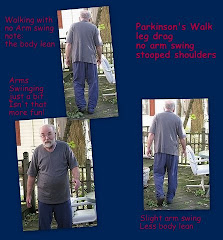In 2003 Cleveland Clinic biomedical engineer Jay Alberts, PhD was on a 480 mile tandem bike trip across the state of Iowa with his friend Kathy who was a PWP (person with Parkinson's) Normally she would pedal at 50-60 rpm, but during this trip with Dr. Alberts she had to pedal at 80-90 RPM. Although the pedaling muscle was provided by Dr Alberts, Kathy's legs moved with the pedals at the speed which he set. When they had gone half the distance they noticed that Kathy's hand tremors had stopped.
Intrigued by Kathy's improvement in motor skills Dr Alberts experimented with another Parkinsons patient in 2006. This patient's symptoms were controlled by an electronic device that had been inserted in his brain by DBS surgery. He rode on the tandem bike with Dr. Alberts for 50 miles with the device turned off. He too exhibited no symptoms during the trip.
This discovery led Dr. Alberts to research Assisted Tandem Bicycle riding based upon his biking and his previous experiences with animal studies. It's called Forced Exercise. "The idea behind it is if we force them to pedal at a higher rate, this allows them to have biochemical changes that are necessary for improvements in motor function," explains Dr. Jay Alberts. "There's a possibility that there's an increase in dopamine or there's an increase in these neuro growth factors."
In a subsequent study with the a voluntary exercise control on a stationary bike or the forced exercise on a tandem bike with a trainer, an improvement of about 30% was measured in the forced exercise group. The improvements declined to 20% about two weeks after the study ended. This suggests the need for regular ongoing forced exercise as a significant part of exercise therapy.
While patients on medication and with deep brain stimulation show a significant improvement with these aids, if the meds are stopped or the DBS is turned off, the patient becomes symptomatic very rapidly. With therapeutic forced exercise, the improvements taper gradually. Dr Alberts feels that the therapies might work well together. By pushing the cyclist past his/her comfort zone by exercising the lower half of the body, the upper half improves. Whether this is a needed stimulus to the central nervous system is still unknown but the goal is to be as symptom free as possible and without the need for medication.
So if the study shows this to be a viable treatment a patient could ride a tandem bike with a friend or family member or use an electric motor driven stationary bike. Because most Parkinson's people cannot pedal at 80-90 rpm, the additional boost to get the leg stimulation comes from either the tandem companion rider or the motor of the stationary bicycle.
I'm hoping that I can convince the Therapy Center to buy a motor driven bike.
references and resources:
Theracycle
Kent State University Magazine summer 2009
ReckMotoMed Website
WNDU.com May 10, 2009
Pedaling to Beat Parkinsons
How You Can Help One Man's Challenge
http://www.lerner.ccf.org/news/documents/LRIMagazineFINAL.pdf
August 4, 2009 Thought you'd like an update
Forced Exercise Appears to Produce Benefits Similar to Levadopa
2011 Addendum:
See PD Trials for contact information about the Dr Albert's Forced Exercise trial, The Therapeutic Effect of Exercise on Parkinson's disease, Study ID: 09-439
2012 Addendum














I have come to the conclusion that the price of the theracycle is simply to high for the average Parkinson's patient. I have looked ( with no success) to find a grant available so I could get some help to afford one. Therefore I am recommending that this organization help those like me to obtain the information necessary to apply for a grant. It would be a great service to the Parkinson's community. Please help us.
ReplyDeleteThere are a few Parkinson's organizations which do have Theracycles available for member use. There is also an exercise center in Arizona which offers supervised Forced Exercise.
ReplyDeleteWe, alas, are not an organization and although we have searched for assistance, most PD monies go for research.
If there is an exercise therapy center in your community, show them this article, perhaps they will consider adding this type of therapy. We did try that here but more patients were recovering from strokes than PD so despite the fact that the Theracycle would have been good for stroke patients as well, the center did not add one when it came time to purchase a new piece of equipment.
On an individual basis, I suggest continuing to monitor for a used Theracycle or equivalent.